Just five days after German Chancellor Merkel pleaded with tears to the public to abide by scientific pandemic prevention regulations, Germany will comprehensively upgrade the pandemic blockade measures.
According to the BBC, on December 13th local time, after consulting with the governors of 16 states, Merkel announced that due to the high number of confirmed cases and deaths of COVID-19 in the country, and even the momentum of “exponential growth”, Germany will implement “hard” from December 16. Lockdown order”, until January 10, 2021.
At present, the pressure on the German health care system is increasing, and the pandemic prevention measures taken since early November are not enough to curb the spread of the pandemic. With Christmas approaching, “we urgently need to do more”.
According to the latest pandemic prevention policy, Germany will close all non-essential places except supermarkets, pharmacies and banks; schools and kindergartens will also stop teaching face-to-face courses; and enterprise employees should suspend work or work from home as much as possible.
How is Germany’s new pandemic prevention measure different from the previous one?
According to the BBC, on December 13th local time, Merkel said at the pandemic press conference, “In recent days, we have seen an increase in the infection rate and an exponential growth, which means that more people may die as a result, and we urgently need to take more action.”
The latest pandemic prevention policy stipulates that from December 16 to January 10, 2021, all non-essential places and entertainment facilities will be closed nationwide in Germany except for supermarkets, pharmacies and banks that are closely related to people’s lives.
Schools and kindergartens will stop teaching face-to-face courses and transfer. For online education; business employers should provide employees with vacation or home-based work programs; restaurants can still provide take-out services, and barbershops need to close.
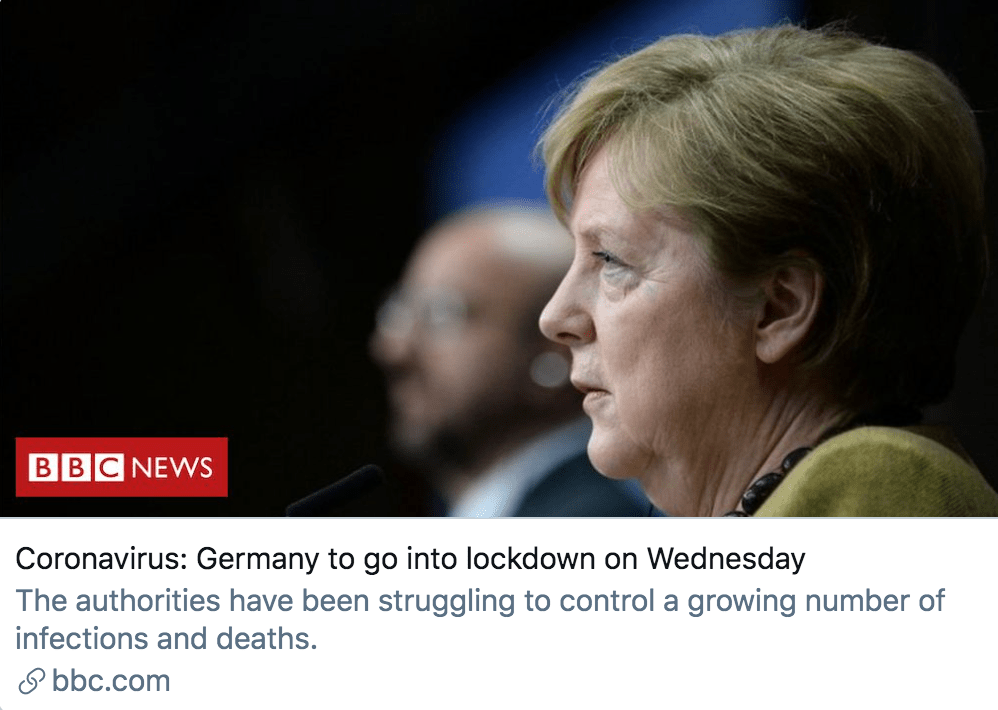
According to the “hard blockade order”, during Christmas, people can meet with relatives and friends, but it must be limited to five people (the number of children is not limited); at the same time, drinking in public places is prohibited and violators will be fined; fireworks and firecrackers are prohibited on New Year’s Eve, and crowd gatherings are prohibited on New Year’s Eve.
Merkel said that the German government aims to reduce the number of new confirmed cases per 100,000 people to less than 50 in seven days, so “we have to take action now”.
According to Deutsche Welle, Germany began to implement a “light lockdown order” on November 2. All restaurants and cafes banned canteen meals, and closed theaters, cinemas, gyms and other places. Schools and kindergartens were basically functioning normally.
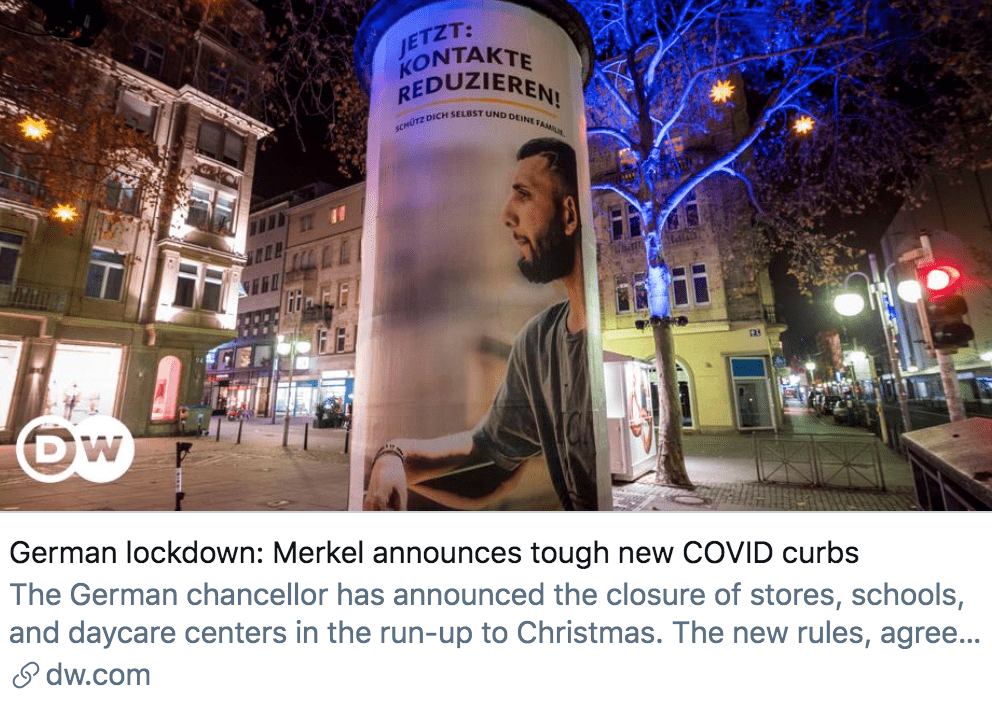
However, these pandemic prevention measures have not yielded substantial results. Confirmed cases and deaths in Germany continue to increase. Merkel also stressed in her speech on December 13 that the “light lockdown order” is obviously not strong enough, and the goal of reducing public exposure by 70% to 75%, under the epidemic prevention measures in early November , up to 40%.
After Merkel announced the new pandemic prevention measures, Deutsche Welle reporter Hans Brandt said, “It was somewhat surprising that the consultations lasted only more than an hour that day, and Chancellor Merkel quickly reached an agreement with the governors of 16 states. In fact, we have long been used to this kind of fierce discussion between the federal government and state governments, which usually takes hours. This pandemic prevention policy is somewhat unusual.
How is the pandemic in Germany?
According to the data released by the Robert Koch Institute for Disease Control and Prevention and Control of Germany on December 13, in the past 24 hours, there have been 20,20 new confirmed cases in Germany, with a cumulative total of more than 1.32 million confirmed cases; 321 new deaths, with a cumulative death of more than 20,000.
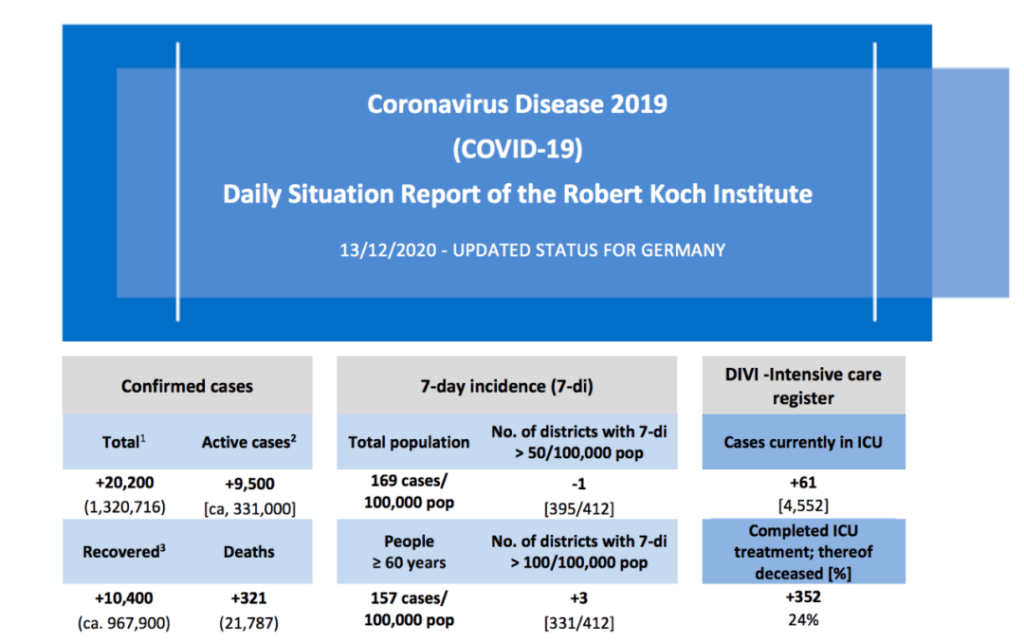
Compared with other European countries, Germany took more effective pandemic prevention measures in the first wave of the pandemic and kept the number of deaths low, but with the onset of winter, the second wave of the pandemic was “surging”.
Since November, the number of new confirmed cases in Germany has exceeded 10,000 almost every day, and even more than 20,000 in a single day, bringing the cumulative number of confirmed cases in Germany to 1 million on November 27th local time.
According to the pandemic report released by the Robert Koch Institute, the number of new confirmed cases in Germany has increased significantly again in a single day since December 4. In the past seven days, the average number of new confirmed cases in 100,000 people nationwide has reached 169, which is far higher than the “safe range” set by the federal government of 50.
At the same time, the German health care system is under great pressure. So far, 4,527 patients have been treated in intensive care units in major German hospitals, which is the largest number since the outbreak in Germany. However, according to Deutsche Welle, only 5 to 10% of intensive care beds are available in Germany.

“At the moment, German hospitals are still able to help people, but if the number of confirmed cases continues to increase, ‘hospitals will no longer work,’” said Uwe Janssens, a member of the German Interdisciplinary Critical and Emergency Medicine Association and ICU physician. The infection situation in the elderly is also of concern, and those aged 70 to 80 years old will have a mortality rate of more than 80% even if they receive intensive care.
Earlier, the governor of Bavaria, Germany, Marcus Soder, warned that “If we are not careful, Germany will soon become a ‘problem child’ in Europe, and for this reason, we must act as soon as possible”.
What pandemic prevention measures have been taken by European countries?
At present, the pandemic situation in European countries is serious. According to the statistics released by the European Center for Disease Control and Prevention, as of December 13 local time, the total number of confirmed cases in the European Union/EEA and the United Kingdom reached 149,59, and the cumulative number of deaths was 372,965.
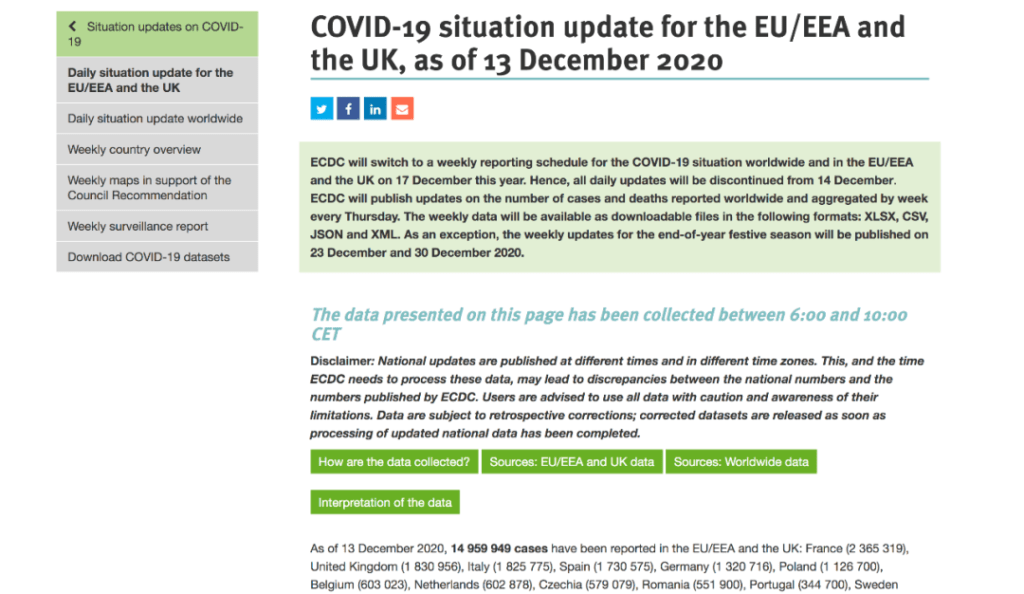
Italy: tighten pandemic prevention restrictions around Christmas
According to the latest statistics released by the Italian Ministry of Health on December 13, in the past 24 hours, 17,938 new confirmed cases have been reported in Italy, with a total of 1843,712 confirmed cases; 484 new deaths, with a total of 64,520 deaths.
According to the data of the European Center for Disease Control and Prevention, as of December 13 local time, Italy’s cumulative death toll has surpassed that of the United Kingdom, becoming the country with the largest cumulative number of deaths in Europe.
In order to curb the spread of the pandemic, Italian Prime Minister Conte listened to the advice of public health experts and tightened pandemic prevention restrictions around Christmas. From December 21 to January 6, 2021, people were prohibited from traveling across regions except for necessary reasons such as work and health and returning to their places of residences and residences. At the same time, Conte also strongly recommends that people avoid visiting relatives and friends and spend the holiday at home as much as possible.
France: Postpon the “unblocking” and resume the curfew
According to the data of the French government website, as of December 13 local time, there were 2,376,852 confirmed cases and 57,911 deaths in France. According to the data of the European Centers for Disease Control and Prevention, France has the largest cumulative number of confirmed cases in Europe.
France has now postponed the “unblocking” due to concerns about the third wave of the pandemic, according to the political news website politico. From December 15th local time, France will also resume the curfew, which will start at 8 p.m. and end at 6 a.m. the next day.
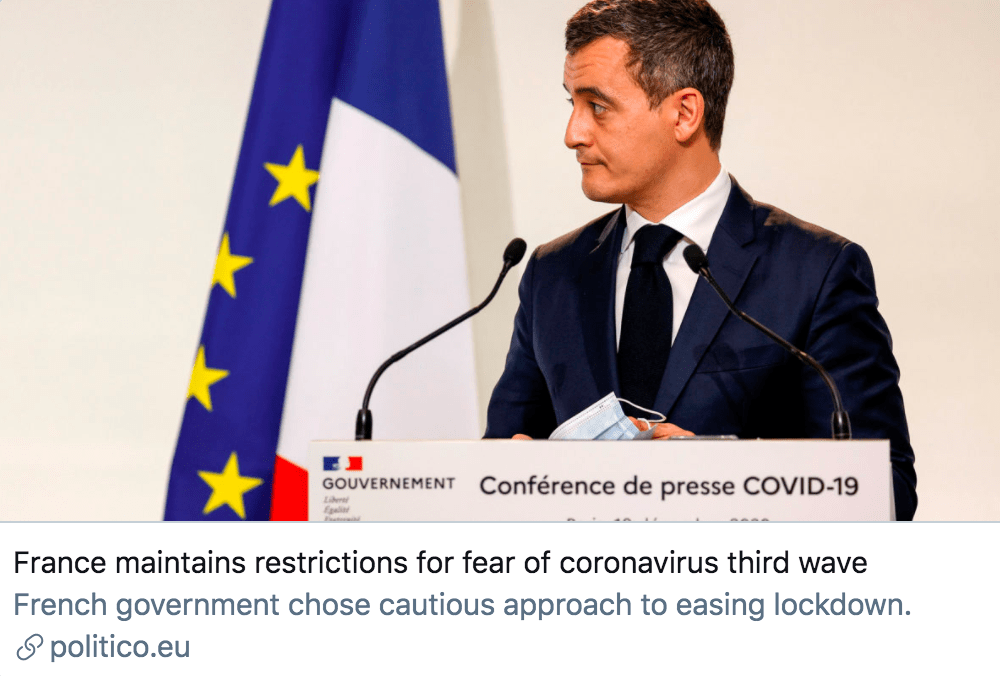
United Kingdom: Launch large-scale coronavirus vaccination project
According to the statistics of the British Department of Health and Social Security, as of December 13, local time, there were a total of 18,49,404 confirmed cases and 64,186 deaths in the United Kingdom.
However, the British government has approved that members from three different families can celebrate the festival indoors during the five-day period from December 23 to 27.
Members of the British government’s emergency science advisory experts worry that this may cause a third wave of pandemic in parts of the UK, and the number of patients hospitalized for treatment will surge, which will eventually overburden the health care system.
However, it is worth noting that on December 8th local time, the United Kingdom officially launched the coronavirus vaccination project, thus becoming the first country in the world to be vaccinated on a large scale.



